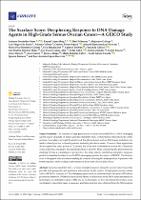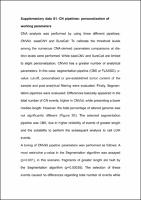| dc.contributor | Vall d'Hebron Barcelona Hospital Campus |
| dc.contributor.author | Fernandez-Serra, Antonio |
| dc.contributor.author | López-Reig, Raquel |
| dc.contributor.author | Márquez, Raúl |
| dc.contributor.author | Gallego, Alejandro |
| dc.contributor.author | De Sande-González, Luis Miguel |
| dc.contributor.author | Yubero Esteban, Alfonso |
| dc.contributor.author | OAKNIN, ANA |
| dc.date.accessioned | 2023-06-14T09:49:05Z |
| dc.date.available | 2023-06-14T09:49:05Z |
| dc.date.issued | 2023-06-01 |
| dc.identifier.citation | Castro E, Maraver A, Fernández-Serra A, López-Reig R, Márquez R, Gallego A, et al. The Scarface Score: Deciphering Response to DNA Damage Agents in High-Grade Serous Ovarian Cancer—A GEICO Study. Cancers. 2023 Jun 1;15(11):3030. |
| dc.identifier.issn | 2072-6694 |
| dc.identifier.uri | https://hdl.handle.net/11351/9746 |
| dc.description | Genomic instability; Machine learning |
| dc.description.abstract | Genomic Instability (GI) is a transversal phenomenon shared by several tumor types that provide both prognostic and predictive information. In the context of high-grade serous ovarian cancer (HGSOC), response to DNA-damaging agents such as platinum-based and poly(ADP-ribose) polymerase inhibitors (PARPi) has been closely linked to deficiencies in the DNA repair machinery by homologous recombination repair (HRR) and GI. In this study, we have developed the Scarface score, an integrative algorithm based on genomic and transcriptomic data obtained from the NGS analysis of a prospective GEICO cohort of 190 formalin-fixed paraffin-embedded (FFPE) tumor samples from patients diagnosed with HGSOC with a median follow up of 31.03 months (5.87–159.27 months). In the first step, three single-source models, including the SNP-based model (accuracy = 0.8077), analyzing 8 SNPs distributed along the genome; the GI-based model (accuracy = 0.9038) interrogating 28 parameters of GI; and the HTG-based model (accuracy = 0.8077), evaluating the expression of 7 genes related with tumor biology; were proved to predict response. Then, an ensemble model called the Scarface score was found to predict response to DNA-damaging agents with an accuracy of 0.9615 and a kappa index of 0.9128 (p < 0.0001). The Scarface Score approaches the routine establishment of GI in the clinical setting, enabling its incorporation as a predictive and prognostic tool in the management of HGSOC. |
| dc.language.iso | eng |
| dc.publisher | MDPI |
| dc.relation.ispartofseries | Cancers;15(11) |
| dc.rights | Attribution 4.0 International |
| dc.rights.uri | http://creativecommons.org/licenses/by/4.0/ |
| dc.source | Scientia |
| dc.subject | Ovaris - Càncer - Aspectes genètics |
| dc.subject | Genòmica |
| dc.subject | Anomalies cromosòmiques |
| dc.subject.mesh | Ovarian Neoplasms |
| dc.subject.mesh | Genomic Instability |
| dc.title | The Scarface Score: Deciphering Response to DNA Damage Agents in High-Grade Serous Ovarian Cancer—A GEICO Study |
| dc.type | info:eu-repo/semantics/article |
| dc.identifier.doi | 10.3390/cancers15113030 |
| dc.subject.decs | neoplasias ováricas |
| dc.subject.decs | inestabilidad genómica |
| dc.relation.publishversion | https://doi.org/10.3390/cancers15113030 |
| dc.type.version | info:eu-repo/semantics/publishedVersion |
| dc.audience | Professionals |
| dc.contributor.organismes | Institut Català de la Salut |
| dc.contributor.authoraffiliation | [Fernández-Serra A, López-Reig R] Molecular Biology Lab, Molecular Biology Department, Instituto Valenciano de Oncologia, Valencia, Spain. Joint IVO-CIPF Cancer Research Unit, Valencia, Spain. [Márquez R] Medical Oncology Department, MD Anderson Cancer Center, Madrid, Spain. [Gallego A] Medical Oncology Department, Hospital Universitario La Paz, Madrid, Spain. [de Sande LM] Medical Oncology Department, Hospital Universitario de León, León, Spain. [Yubero A] Medical Oncology Department, Hospital Clínico Universitario Lozano Blesa, Zaragoza, Spain. [Oaknin A] Servei d’Oncologia Mèdica, Vall d’Hebron Hospital Universitari, Barcelona, Spain |
| dc.identifier.pmid | 37296992 |
| dc.rights.accessrights | info:eu-repo/semantics/openAccess |

 Private area
Private area Contact Us
Contact Us








